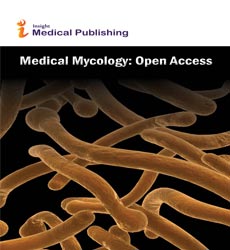Abstract
Use of Polymerase chain Reaction for Cryptococcus neoformans Genome Detection in Cerebrospinal Fluid for Neurocryptococcosis Diagnosis
Cryptococcosis is a systemic infection caused by encapsulated yeast of Cryptococcus genus, has a worldwide distribution, affecting about 1/3 of human immunodeficiency virus (HIV) carriers and thus, is considered an opportunistic infection. Rapid and specific diagnostic tests for fungal infections are extremely important to effective treatment of infected patients. With the progress of molecular biology has been possible to develop new techniques for diagnosis and Cryptococcus spp identification. This study aimed standardizes a Cryptococcus spp DNA extraction method; determine the detection limit of fungus genome by PCR (Polymerase Chain Reaction) technique and determine the sensitivity and specificity of this technique in biological samples from infected patients. To standardize the DNA extraction were compared two ways for breaking fungus cell wall: the first one, using only glass beads, and the second one, using CTAB reagent. For standardization of conventional PCR and real time PCR (q-PCR), primers previously described were used, specific for Cryptococcus genus (CN4-CN5). A culture of C. neoformans (ATCC 24067) was used as a positive control. For q-PCR standardization for Cryptococcus spp genome detection and quantification in cerebrospinal fluid (CSF) were used 56 samples collected from positive neurocryptococcosis patients, which diagnostic was confirmed by other tests such as India ink, culture, latex and clinical findings. As negative control were used 44 CSF samples collected from negative neurocryptococcosis patients, according the same tests mentioned above. To confirm the specificity of the primers, q-PCR was tested in genomes of other fungal species. According to the results, no significant difference was observed between two DNA extraction methods, suggesting that for DNA extraction in CSF samples it is not necessary to use CTAB to lyse the fungus cell wall. The CTAB residues may inhibit the q-PCR, which is highly sensitive and requires a high degree of purity of the DNA. With respect to the detection limit, it was observed that the lowest DNA concentration detected by q-PCR was 47.0 femtograms (10-5) DNA/µL. The specificity test showed that primers were 100% specific, because it was not aligned in the other fungi species genomes tested. All 56 CSF samples of confirmed neurocryptococcosis patients were positive in q-PCR, while 18 (18.8%) CSF samples among negative neurocryptococcosis patients group were positive in q-PCR. This divergence of results can be explained by the fact that q-PCR has higher sensitivity than other tests used in cryptococcal meningitis diagnosis. Therefore, the q-PCR technique proved to be feasible for neurocryptococcosis diagnosis support, after it is well standardized, as in this study.
Author(s):
Graciele-Melo Cidiane, Rocha-Silva Fabiana, Christo Paulo Pereira and Caligiorne Rachel Basques
Abstract | Full-Text | PDF
Share this

Google scholar citation report
Citations : 164
Medical Mycology: Open Access received 164 citations as per google scholar report
Abstracted/Indexed in
- Google Scholar
- China National Knowledge Infrastructure (CNKI)
- Directory of Research Journal Indexing (DRJI)
- WorldCat
- Publons
- Geneva Foundation for Medical Education and Research
- Secret Search Engine Labs
Open Access Journals
- Aquaculture & Veterinary Science
- Chemistry & Chemical Sciences
- Clinical Sciences
- Engineering
- General Science
- Genetics & Molecular Biology
- Health Care & Nursing
- Immunology & Microbiology
- Materials Science
- Mathematics & Physics
- Medical Sciences
- Neurology & Psychiatry
- Oncology & Cancer Science
- Pharmaceutical Sciences
